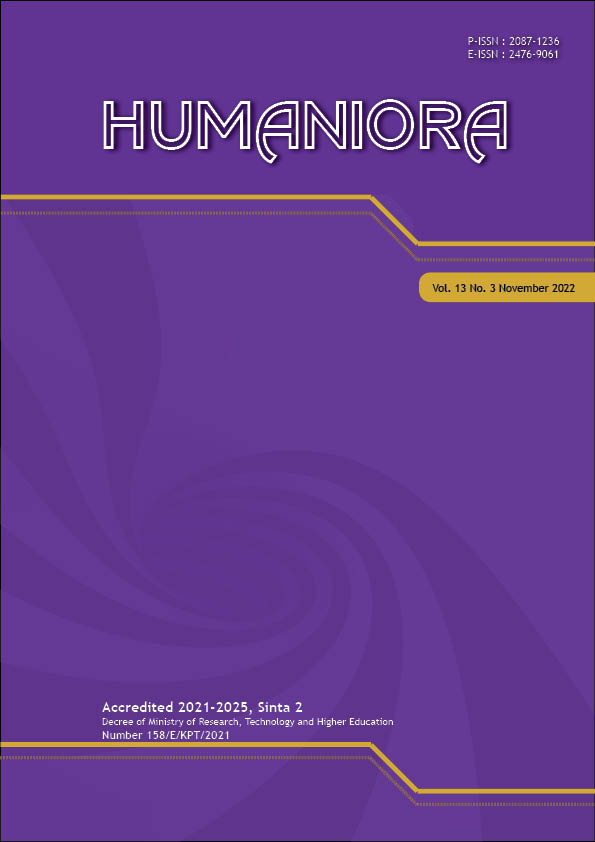The Impact of Japanese Popular Culture to Indonesian younger Generation:
A Case Study of PUNICO
DOI:
https://doi.org/10.21512/humaniora.v13i3.8131Keywords:
japanese popular culture, local culture, young generationAbstract
The research probed into the influence of Japanese popular cultures on the Indonesian-younger generation in Cikarang, West Java, Indonesia. Japanese popular culture had been famed among the younger generation in Indonesia through the increasing popularity of anime. Indonesia, with 1.400 ethnic groups, had a variety of cultural diversity, but the younger generation seemed to be fonder of this foreign culture which in this case was Japanese popular culture. Through the expansion of this Japanese popular culture, Japanese culture could slip into it and could invade their local culture. This cultural expansion could have an impact on how the younger generation would preserve their local culture. Globalization also played a massive part in this cultural expansion; through the internet, it was easier to find something with foreign culture in it. The research used phenomenology research about the Japanese popular culture club of President University Nippon Community (PUNICO) in Cikarang. The research applied a qualitative approach with phenomenology methods. Data collection was done by asking the respondents questions regarding the matter. The respondents were ten members of PUNICO. The research result indicates that Japanese popular culture has been in the respondent's life long enough to change their habits and lifestyle. However, the respondents still care and have the volition to preserve their local cultures.Â
References
Agus, E., & Zulfahmi. (2021). Pengaruh globalisasi terhadap nilai nasionalisme generasi muda. Jurnal Kajian Hukum, 2(1), 26-33. https://doi.org/10.55357/is.v2i1.75.
Auwalin, I. (2020). Ethnic identity and internal migration decision in Indonesia. Journal of Ethnic and Migration Studies, 46(13), 2841-2861. https://doi.org/10.1080/1369183X.2018.1561252.
Hassan, N. A., Sallehuddin, I. S., & Aziz, N. N. A. (2018). Acceptance of anime among university students. Jurnal Sultan Alauddin Sulaiman Shah, 5(1), 195-205.
Hatami, W. (2018). Popular culture of Japanese anime in the digital age and the impact on nationalism of young Indonesian citizens. Journal of Social Studies, 14(1), 37-47. https://doi.org/10.21831/jss.v14i1.216522.
Kadafi, M., & Utami, S. M. B. (2021). Locality in Makoto Shinkai’s Kimi no Na wa: Negotiating Japanese youth identity. Izumi, 10(1), 21-31. https://doi.org/10.14710/izumi.10.1.21-31.
Kalu, F. A., & Bwalya, J. C. (2017). What makes qualitative research good research? An exploratory analysis of critical elements. International Journal of Social Science Research, 5(2), 43-56. https://doi.org/10.5296/ijssr.v5i2.10711.
Kusumawardhani, E., & Sari, D. S. (2021). Gelombang pop culture TikTok: Studi kasus Amerika Serikat, Jepang, India dan Indonesia. Padjadjaran Journal of International Relations, 3(1), 19-31. https://doi.org/10.24198/padjir.v3i1.27758.
Levin, I., & Mamlok, D. (2021). Culture and society in the digital age. Information (Switzerland), 12(2), 1-13. https://doi.org/10.3390/info12020068.
Mubah, A. S. (2019). Japanese public diplomacy in Indonesia: The role of Japanese agencies in academic exchange programs between Japan and Indonesia. Jurnal Global & Strategis, 13(1), 37-50. https://doi.org/10.20473/jgs.13.1.2019.37-50.
Prabowo, R. M. (2017). Consumerism capitalist perspective in animation film Sen To Chihiro No Kamikaushi by Hayao Miyazaki. Humaniora, 8(4), 349-359. https://doi.org/10.21512/humaniora.v8i4.3906.
Pratama, A. D., & Puspitasari, A. (2020). Diplomasi budaya Anime sebagai upaya penguatan soft power Jepang periode 2014-2018. Balcony, 4(1), 11-23.
Putra, T. K., Rochsantiningsih, D., & Supriyadi, S. (2020). Cultural representation and intercultural interaction in textbooks of English as an international language. Journal on English as a Foreign Language, 10(1), 163-184. https://doi.org/10.23971/jefl.v10i1.1766.
Putri, F., & Indrawati, I. (2020). Diplomasi dua budaya: Studi kasus perbandingan strategi diplomasi pop culture Korea Selatan dan Jepang di Indonesia. Global Insight Journal, 4(2), 1-29. https://doi.org/10.52447/gij.v4i2.3734.
Szmelter. (2020). Contemporary conservation theory in the context of the valuation of cultural heritage. In Between Science and Art. Warsaw: Academy of Fine Art.
Venus, A., & Helmi, L. (2017). Budaya populer Jepang di Indonesia: Catatan studi fenomenologis tentang konsep diri anggota cosplay party Bandung. Jurnal Aspikom: Asosiasi Pendidikan Tinggi Ilmu Komunikasi, 1(1), 71-90. https://doi.org/10.24329/aspikom.v1i1.9.
Wahidati, L., Kharismawati, M., & Mahendra A. O. (2018). Pengaruh konsumsi anime dan manga terhadap pembelajaran budaya dan bahasa Jepang. Izumi, 7(1), 1-10. https://doi.org/10.14710/izumi.7.1.1-10.
Yuliani, R., Mulyadi, R. M., & Adji, M. (2021). Japanese soft power in Indonesia on anime entitled UFO Baby: Study of popular culture. Izumi, 10(2), 328-337. https://doi.org/10.14710/izumi.10.2.328-337.
Downloads
Published
How to Cite
Issue
Section
License
Copyright (c) 2022 Bunga Putra Bangsa

This work is licensed under a Creative Commons Attribution-ShareAlike 4.0 International License.
Authors who publish with this journal agree to the following terms:
a. Authors retain copyright and grant the journal right of first publication with the work simultaneously licensed under a Creative Commons Attribution License - Share Alike that allows others to share the work with an acknowledgment of the work's authorship and initial publication in this journal.
b. Authors are able to enter into separate, additional contractual arrangements for the non-exclusive distribution of the journal's published version of the work (e.g., post it to an institutional repository or publish it in a book), with an acknowledgment of its initial publication in this journal.
c. Authors are permitted and encouraged to post their work online (e.g., in institutional repositories or on their website) prior to and during the submission process, as it can lead to productive exchanges, as well as earlier and greater citation of published work.
USER RIGHTS
All articles published Open Access will be immediately and permanently free for everyone to read and download. We are continuously working with our author communities to select the best choice of license options, currently being defined for this journal as follows: Creative Commons Attribution-Share Alike (CC BY-SA)




















